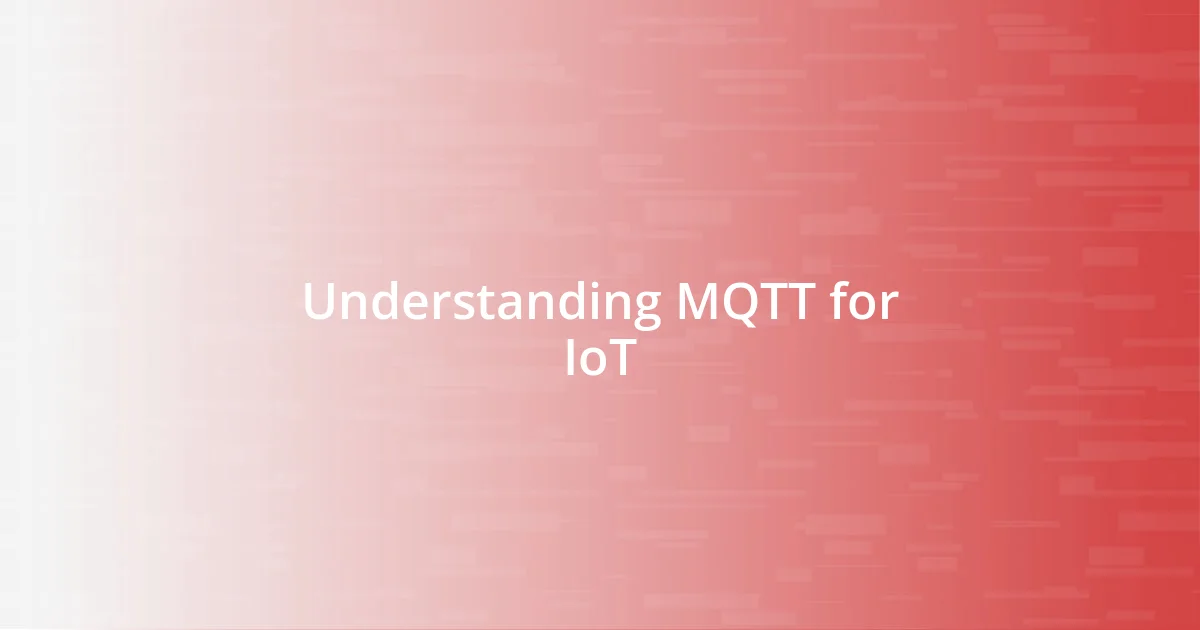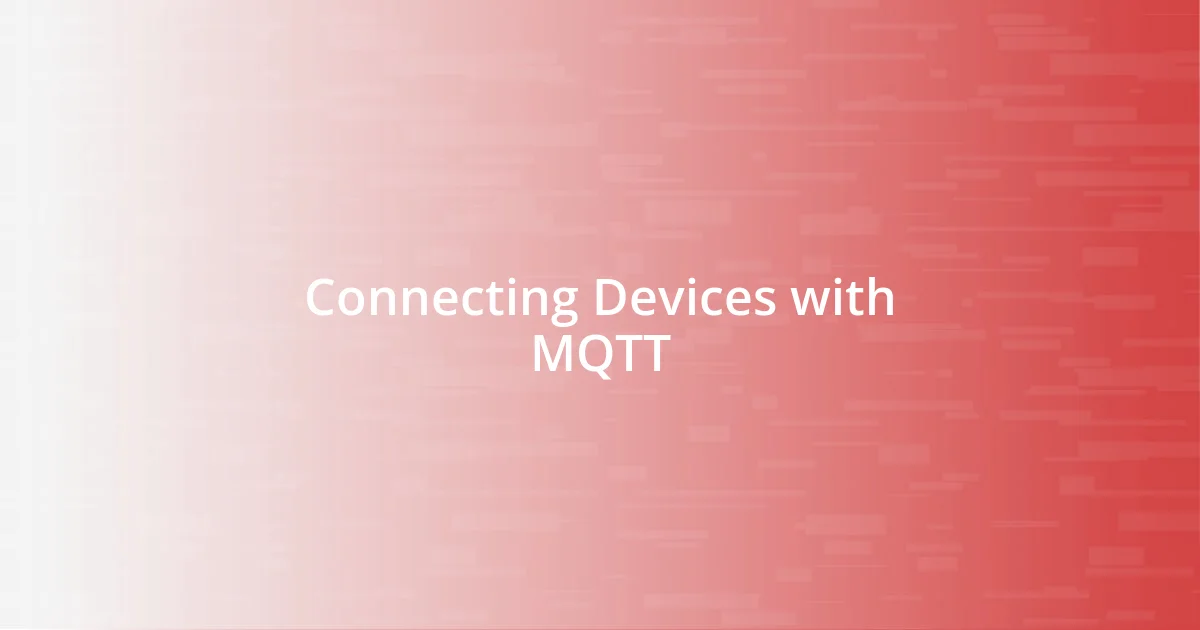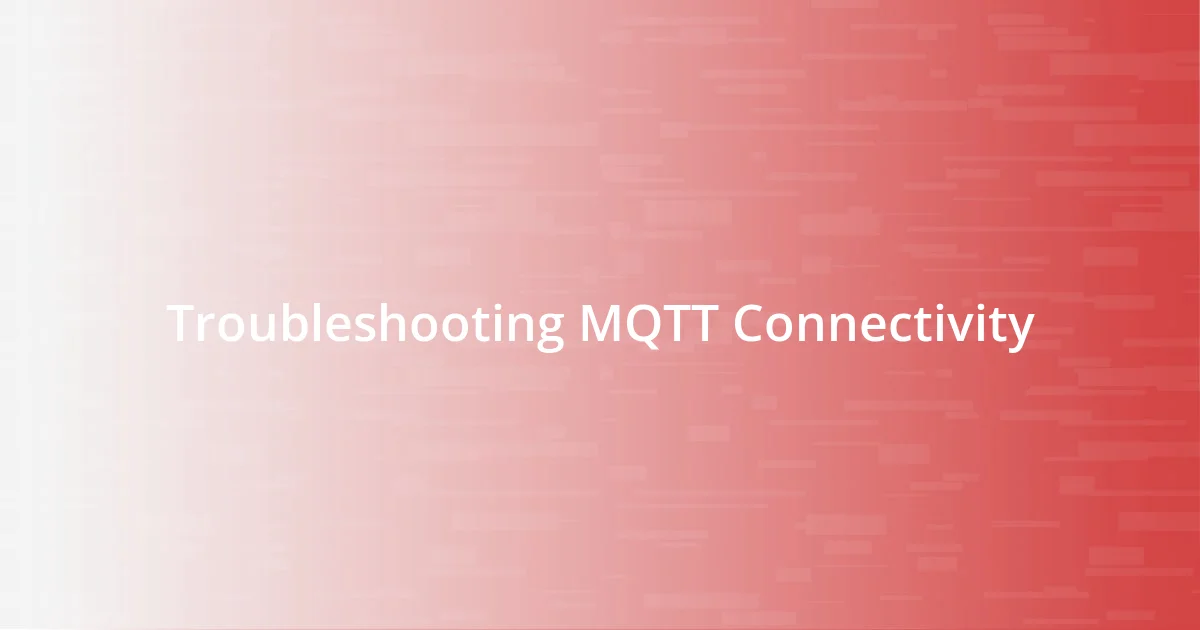Key takeaways:
- MQTT’s publish/subscribe model allows seamless device communication without requiring direct IP address knowledge, enhancing connectivity in IoT applications.
- Implementing security measures, like TLS encryption and authentication, is crucial for protecting sensitive data in MQTT communications.
- Real-world applications of MQTT range from smart home devices to agricultural monitoring and industrial automation, showcasing its versatility and impact on efficiency and productivity.

Understanding MQTT for IoT
When I first delved into MQTT, I was struck by its simplicity and efficiency, especially for IoT applications. It uses a publish/subscribe model, which means devices can communicate seamlessly without knowing each other’s IP addresses. Doesn’t that just make you think how much easier our lives could be with this streamlined approach?
I remember setting up my first MQTT broker and connecting a few devices—it felt like magic watching them all communicate in real-time. What really amazed me was how lightweight the protocol is; it’s designed to work efficiently even over low-bandwidth connections or flaky networks. Have you ever experienced a moment when you’re surprised by how something so simple can work so well?
Understanding the quality of service within MQTT was a game-changer for me. It has three levels for message delivery guarantee, allowing me to choose the right fit depending on the criticality of the messages. This feature really resonated with me, especially when I think about the implications for things like security systems or health monitoring—where every message counts. It makes you wonder how MQTT’s reliability could enhance the safety and convenience of our daily lives.

Setting Up MQTT Broker
Setting up an MQTT broker might sound daunting at first, but it’s actually quite straightforward. In my experience, I opted for Mosquitto, a popular open-source broker that provides excellent support for both beginners and seasoned developers. Once I had it installed, configuring it was simply a matter of editing a few configuration files to tailor the setup to my needs. Seeing my devices connect to the broker and publish their first messages felt like I was finally opening the door to a whole new world of communication between my IoT devices.
To ensure a smooth installation and operation of your MQTT broker, consider these essential steps:
- Choose the right broker software (e.g., Mosquitto, HiveMQ, EMQX).
- Install the broker on your platform of choice (Linux, Windows, or macOS).
- Edit the configuration file to set up desired settings like authentication and port numbers.
- Enable necessary security features, such as SSL/TLS encryption where required.
- Test the broker with a lightweight client to confirm that it’s functioning correctly.
Each step can bring a sense of accomplishment, especially when you witness the seamless interaction between your devices. I still remember the thrill of seeing my simple setup successfully publish and subscribe to messages. It was a reminder of the power of IoT and how these little steps make a significant impact in the grand scheme of things.

Connecting Devices with MQTT
Connecting devices with MQTT can be as exhilarating as it is straightforward. I still vividly recall the moment I had my first device publish its status update to the MQTT broker. Watching the data flow dynamically from one device to another was incredibly satisfying. The flexibility of MQTT allows various devices, from sensors to actuators, to come together seamlessly. Isn’t it amazing how a simple protocol can connect devices in such a harmonious way?
As I explored more on linking devices, I realized that addressing the data format can make all the difference. In my case, I chose JSON for message formatting, making it easy for devices to parse and understand the information. The beauty of MQTT is its adaptability; you can connect a variety of devices, no matter their design or function. I often think about the times I was frustrated trying to connect different systems—MQTT transformed that experience into one of simplicity and ease.
When setting up subscriptions for different topics, I found myself always pondering the potential applications. For example, I used temperature sensors to monitor a greenhouse environment. Each time the sensor published a new reading, I felt like I was getting instant feedback on how well the plants were doing. This real-time interaction not only made my project more efficient but also enhanced my engagement with the entire process. And to think that it all started with a few lines of code—it was a daunting task at first, but the rewards of seeing those connections flourish kept me motivated.
| Device Type | Connection Method |
|---|---|
| Sensors | Publish messages with updates |
| Actuators | Subscribe and respond to control commands |
| Data Aggregators | Listen for multiple sensor messages |
| Mobile Apps | Interact with broker for real-time updates |

Publishing and Subscribing to Topics
Publishing and subscribing to topics in MQTT form the backbone of effective communication among IoT devices. When I first started publishing messages, I remember the nervous excitement of hitting “send” on a message from one of my sensors. The moment I saw it successfully show up on my subscriber’s end, I couldn’t help but smile—what a powerful feeling to see technology work as intended!
The subscription model in MQTT intrigued me, especially because it allows devices to respond dynamically to incoming messages. For instance, when I set up a fan system to respond to temperature readings, it felt amazing to fine-tune the process. I’d watch the fan kick on when the temperature crossed a specific threshold, almost as if it had a mind of its own. It made me wonder—how many other creative solutions could arise from understanding and leveraging this topic-based system?
Delving into topic structures really opened my eyes to the possibilities. Initially, my topics were simple, like “home/livingroom/temperature.” However, as my project evolved, I created a hierarchy that grouped similar devices together. I still remember the thrill of seeing my tree of topics grow, each leaf representing a device, a pulse of data flowing through my setup. How could such a simple system bring such depth to my projects? It’s fascinating to consider the endless potential in organizing our communication pathways so intentionally.

Implementing Security in MQTT
Security needs to be a top priority when implementing MQTT in IoT. During my initial experiments, I remember feeling uneasy about the potential vulnerabilities, especially when my devices transmitted sensitive data. To mitigate risks, I started using Transport Layer Security (TLS), which encrypts the messages transferred between the devices and the broker. It felt reassuring knowing that even if someone intercepted the data, they wouldn’t be able to make sense of it.
Another critical security aspect I focused on was user authentication. I still recall the moment I realized that simply having open access could lead to unauthorized users meddling with my devices. I implemented username and password authentication for devices connecting to the MQTT broker. This added a layer of protection and gave me peace of mind knowing that only authorized devices could communicate efficiently, like a trusted bouncer keeping an eye on who enters the club.
As I delved deeper, the concept of Access Control Lists (ACLs) became apparent to me. Setting different permissions for each device was like giving each one a unique role in a grand symphony—some could publish data, while others could only subscribe. Adjusting these permissions became almost second nature, and I often asked myself: how much trust do I want to extend to each device? This question guided my approach in shaping a secure yet functional IoT environment.

Troubleshooting MQTT Connectivity
When it comes to troubleshooting MQTT connectivity, the first step I take is to ensure that all devices are properly connected to the same network. I remember a moment of frustration when my devices were refusing to communicate, only to realize that they were on different Wi-Fi bands. It’s a tiny detail, but it can cascade into a connectivity nightmare. Have you ever double-checked your network settings? I’ve found that a simple reconfiguration often resolves the issue.
If your devices are connected, but messages aren’t being sent or received, it’s worth checking the MQTT broker’s logs. I experienced a puzzling instance where messages seemed to vanish into thin air, and upon reviewing the logs, I discovered that my subscription settings were misconfigured. The logs provided a clear trail of what went wrong—like a roadmap guiding me back to the right path. It’s fascinating how much information those logs can provide, don’t you think?
Lastly, consider the quality of your message payloads. I vividly recall sending a large data packet that caused my broker to choke. The result? A complete breakdown in communication. I learned to keep my payloads lightweight and within a reasonable size limit to prevent such mishaps. This experience taught me the importance of testing with various message sizes to ensure that everything runs smoothly. What lessons have you learned firsthand about message optimization?

Real World Applications of MQTT
When I first explored the world of smart home devices, I was amazed by how MQTT facilitated communication between everything, from lights to thermostats. One evening, I adjusted my home’s temperature remotely while enjoying a movie, marveling at how MQTT allowed my devices to react instantly to my commands. This kind of real-time interaction truly transforms everyday living, making routines more efficient and enjoyable.
In the agricultural sector, I stumbled upon fascinating applications of MQTT monitoring environments like greenhouses. I was captivated by stories of farmers using MQTT to track moisture levels and temperature in real time, enabling them to optimize water usage. Just imagining how much waste could be reduced while increasing crop yields felt inspiring; it’s amazing what technology can achieve when it’s put into the hands of those who need it most.
Industrial automation is another area where MQTT shines. Picture this: manufacturing units exchanging data seamlessly to improve machinery efficiency. I still remember reading about a factory that utilized MQTT to streamline its production line. The reduced downtime and enhanced productivity rates were incredible to see! Have you ever thought about how connectivity like this could redefine traditional industries? It’s not just about communication; it’s about transforming operational realities.













